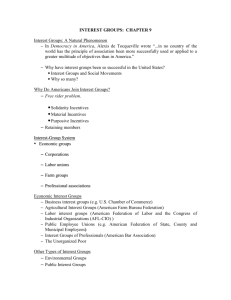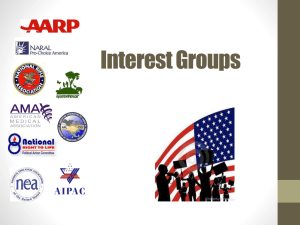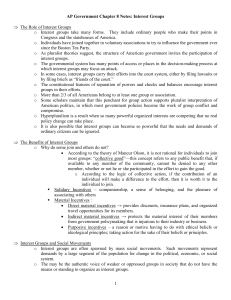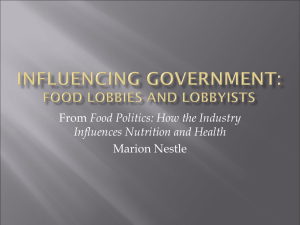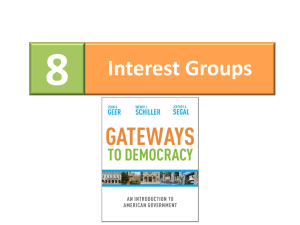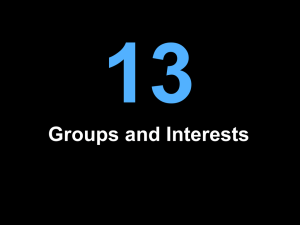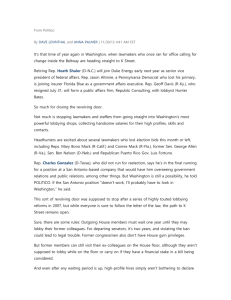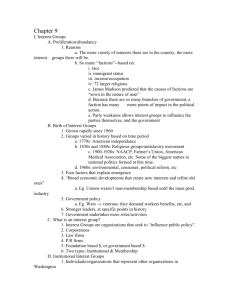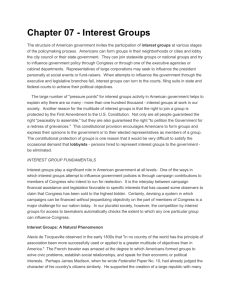interest groups - Jb-hdnp
advertisement
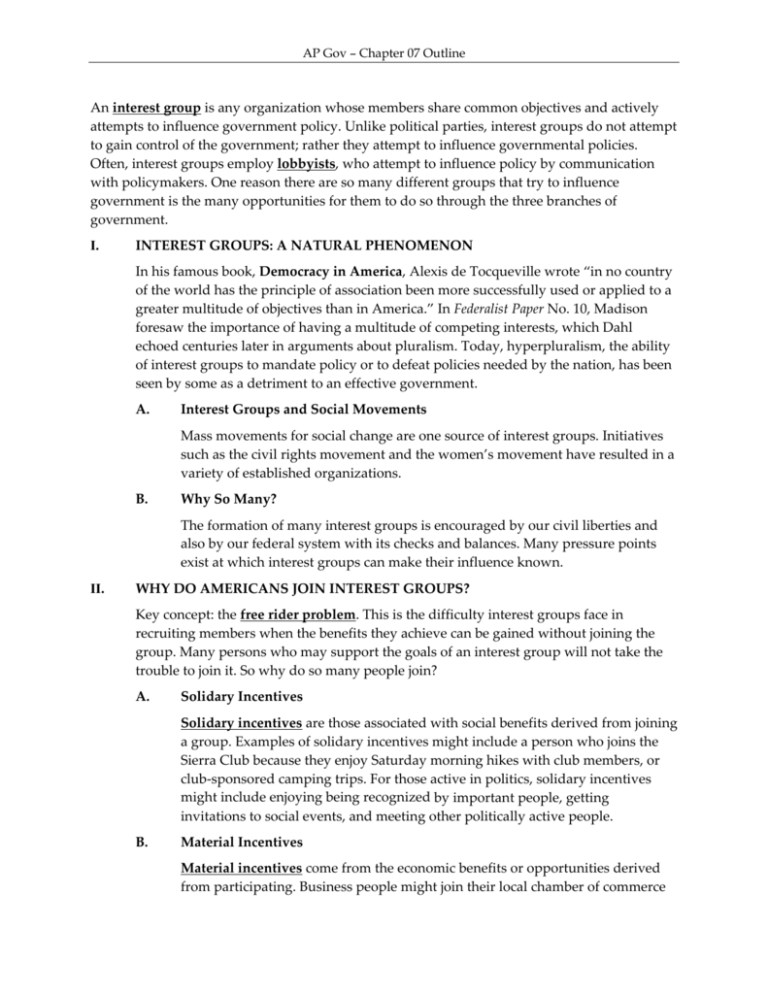
AP Gov – Chapter 07 Outline An interest group is any organization whose members share common objectives and actively attempts to influence government policy. Unlike political parties, interest groups do not attempt to gain control of the government; rather they attempt to influence governmental policies. Often, interest groups employ lobbyists, who attempt to influence policy by communication with policymakers. One reason there are so many different groups that try to influence government is the many opportunities for them to do so through the three branches of government. I. INTEREST GROUPS: A NATURAL PHENOMENON In his famous book, Democracy in America, Alexis de Tocqueville wrote “in no country of the world has the principle of association been more successfully used or applied to a greater multitude of objectives than in America.” In Federalist Paper No. 10, Madison foresaw the importance of having a multitude of competing interests, which Dahl echoed centuries later in arguments about pluralism. Today, hyperpluralism, the ability of interest groups to mandate policy or to defeat policies needed by the nation, has been seen by some as a detriment to an effective government. A. Interest Groups and Social Movements Mass movements for social change are one source of interest groups. Initiatives such as the civil rights movement and the women’s movement have resulted in a variety of established organizations. B. Why So Many? The formation of many interest groups is encouraged by our civil liberties and also by our federal system with its checks and balances. Many pressure points exist at which interest groups can make their influence known. II. WHY DO AMERICANS JOIN INTEREST GROUPS? Key concept: the free rider problem. This is the difficulty interest groups face in recruiting members when the benefits they achieve can be gained without joining the group. Many persons who may support the goals of an interest group will not take the trouble to join it. So why do so many people join? A. Solidary Incentives Solidary incentives are those associated with social benefits derived from joining a group. Examples of solidary incentives might include a person who joins the Sierra Club because they enjoy Saturday morning hikes with club members, or club‐sponsored camping trips. For those active in politics, solidary incentives might include enjoying being recognized by important people, getting invitations to social events, and meeting other politically active people. B. Material Incentives Material incentives come from the economic benefits or opportunities derived from participating. Business people might join their local chamber of commerce AP Gov – Chapter 07 Outline to “network” and to try to lobby local leaders for business‐friendly policies. Others might become active in an interest group in the hopes of gaining employment or business opportunities. C. Purposive Incentives Purposive incentives come from personal beliefs and commitments to an issue and relate to the satisfaction one derives from taking action when the goals of a group correspond with personal beliefs or principles. Purposive incentives can be issue‐oriented and/or ideological. Examples might include abortion, gun control, or environmental causes. III. TYPES OF INTEREST GROUPS There are thousands of interest groups in the United States. Some are active at the national level, others at the state level, some at the local level, and some at all levels of government. A. Economic Interest Groups 1. Business Interest Groups. Business interest groups are those economic interest groups whose purpose is to influence policy in a direction favorable to the business community. Although there are numerous specific organizations, an example of a business interest group is The National Association of Manufacturers (NAM), which has a staff of more than 60 people. It is a proponent of the interests of large corporations with a focus on labor laws, minimum wage rates, corporate taxes, and trade regulations. A second example of a business interest group is the U.S. Chamber of Commerce, a national organization for local chambers of commerce. It represents the interests of over 3,500 local chambers and over 200,000 businesses. The diversity in business types means that the business community is not always unified in its policy preferences (e.g., big versus small business, immigration reform, and so on). 2. Agricultural Interest Groups. These are economic interest groups whose purpose is to influence policy in a direction favorable to farmers or agricultural‐related businesses. Examples include the American Farm Bureau Federation (AFBF) and the National Farmers’ Union (NFU). As farms have become larger, single‐issue farm groups have emerged (e.g., American Dairy Association, Peanut Growers Group, and so on). 3. Labor Interest Groups. Labor interest groups are economic interest groups whose purpose is to influence policy in a direction favorable to organized labor. Millions of workers belong to various labor unions that support specific labor interest groups. The American Federation of Labor and the Congress of Industrial Organizations (AFL‐CIO) is the largest labor organization in the United States. It is a federation of numerous, diverse labor organizations, like the American Federation of Teachers AP Gov – Chapter 07 Outline (AFT), the International Brotherhood of Teamsters (IBT), and the United Automobile Workers (UAW). Its focus is on labor standards, benefits, wages, housing, and foreign trade. The political arm of the AFL‐CIO is called COPE, or the Committee on Political Education. The number of workers represented by unions in the private sector has fallen in recent decades, which has reduced labor’s strength. Another factor that may reduce labor’s strength was the split in the AFL‐CIO occurring in 2005, as four key unions left the federation and formed the Change to Win Coalition. This new coalition represents about one‐third of the 13 million workers that formerly belonged to the AFL‐CIO. Public sector union membership exceeds membership in private sector unions today. B. 4. Public Employee Unions. Public employee pressure groups are relatively new in the arena of interest groups. These organizations represent workers employed by governments. Many employees of fire departments, police departments, sanitation departments, and public schools are union members or represented by a union. Examples of public employee unions include the American Federation of State, County and Municipal Employees (AFSCME) and the National Education Association (NEA). These organizations attempt to influence policy locally and nationally concerning working conditions, wages, benefits, and long‐term public policy related to these areas. 5. Interest Groups of Professionals. Professional interest groups represent individuals with specific credentials. These interest groups attempt to influence policies that have an impact on the members of the profession. Examples are the American Bar Association (ABA; attorneys) and the American Medical Association (AMA; physicians). 6. The Unorganized Poor. In general, persons in poverty lack the time and money needed to join interest groups. To the extent that such persons are represented at all, they are represented by others, such as social workers’ groups, public‐interest groups, churches, charities, and liberal organizations. Environmental Groups Environmental interest groups are concerned with policy affecting the environment. Environmental groups are concerned with global issues as well as national or state issues. The goal of most interest groups in this category is the preservation of resources, land, and wildlife. Examples include the Sierra Club and Greenpeace. C. Public‐Interest Groups Public‐interest groups are often consumer groups. The goal of such groups is to influence policy that affects consumers. In the past, consumer interest groups AP Gov – Chapter 07 Outline have lobbied to have rear shoulder harnesses installed in all new vehicles, and have succeeded in requiring automobile manufacturers to put eye‐level brake lights in cars’ rear windshields. D. 1. Nader Organizations. The public‐interest movement has been headed by consumer advocate Ralph Nader, who also ran for president of the United States in 2000 and 2004. Nader was responsible for founding hundreds of such groups. 2. Other Public‐Interest Groups. Other such groups include Common Cause, the League of Women Voters, and MoveOn.org. Conservative public‐interest groups have also sprung up to fight consumer and environmental groups in court. Other Interest Groups Many special interest groups focus on a single issue. These are narrowly focused groups that may avoid involvement with policies that do not directly affect the major issue of the organization. Examples include interest groups concerned with abortion or gun control. The AARP, formerly the American Association of Retired People, could be put in this class. It is one of the most powerful interest groups of all, along with the National Rifle Association. E. Foreign Governments Foreign governments also act to promote the goals of their businesses and interests of their nations by influencing policy decisions adopted by the government of the United States. IV. WHAT MAKES AN INTEREST GROUP POWERFUL? A. Size and Resources The size of a group’s membership and the extent of its financial resources are important indicators of the importance of an interest group. Groups such as the AARP have huge memberships. Groups such as the pharmaceutical lobby have few members but vast financial resources. B. Leadership Individual leaders with power and charisma are another determinant of a group’s power. An example is the extraordinary leadership of the American Israel Public Affairs Committee (AIPAC) that has been instrumental in fostering a positive relationship between the United States and Israel. C. Cohesiveness This refers to how strongly the members of the group believe in their cause and how hard they are willing to work for that issue. AP Gov – Chapter 07 Outline V. INTEREST GROUP STRATEGIES For an interest group to be successful, it must be able to influence officials who are responsible for making public policy. There are two primary methods used to influence officials of the government: Direct action to influence the official and indirect action (an attempt to have others take action to influence the official). A. Direct Techniques 1. B. Lobbying Techniques. This can include direct discussion with policymakers concerning the views of the interest group. This is usually thought of as occurring with members of the legislature, although members of the executive branch are also frequent targets of lobbyists. Effective lobbyists will use all of the following techniques to present information to policymakers: meeting privately with public officials; testifying before congressional committees; testifying before executive rule‐making agencies; submitting proposed legislation to members of the legislature for introduction; arranging social gatherings for informal discussions; and providing information to legislators. 2. The Ratings Game. This involves interest groups publishing the voting records of members of the legislature. A higher rating means support on issues important to the group. A lower rating means opposition on issues important to the interest group. 3. Building Alliances. This is an effort to unite groups that have common goals. The tactic is useful in projecting a positive image to the public and to the policymakers and in avoiding duplication. During the Bush administration, Republicans launched the K Street Project, designed to re‐ shape the lobbying community in support of a more conservative agenda. 4. Campaign Assistance. This includes endorsements for election, unpaid volunteers who work for the election of the candidate, and publicizing the candidate to the group’s own members. The 2009 Supreme Court ruling in Citizens United v. Federal Election Commission will likely make it possible for unions, interest groups, and corporations to spend money directly on advertising for and against candidates in the 2010 elections if Congress does not take action to overturn the decision. Indirect Techniques 1. Generating Public Pressure. This can be done by informing the public about a specific issue, often by advertising in newspapers, radio, and AP Gov – Chapter 07 Outline television or through Internet appeals. Climate control is the use of public relations techniques to create favorable public opinion toward an interest group, industry, or corporation. VI. 2. Using Constituents as Lobbyists. This requires the interest group to convince its members to contact a member of the legislature by mail or phone about a specific legislative proposal. The Internet has proved a valuable tool for interest groups, who can use new technologies to easily connect to thousands of members, and facilitate their contact of government officials. This use of large numbers of constituents is sometimes known as the shotgun approach. In the rifle technique (the Utah plant manager theory), the interest group relies on lobbying by a constituent who is of local importance. 3. Unconventional Forms of Pressure. These include marches, rallies, and demonstrations, which have often been used by organizations seeking social change. Violent demonstrations, however, can backfire by alienating the public. The boycott is another technique. It involves widespread refusal to buy a good or service in order to place pressure on the provider. Boycotts were used to desegregate buses in Montgomery, Alabama, and by Mexican‐American farm workers seeking to organize a union. REGULATING LOBBYISTS The Federal Regulation of Lobbying Act (1946) required that individuals or organizations that receive money for the purpose of influencing national legislation register as a lobbyist or lobbying organization, and registered lobbyists were required to make public quarterly reports about all lobbying activity. The Federal Regulation of Lobbying Act was challenged in United States v. Harriss (1954). The Supreme Court ruled that the law did not violate due process, freedom of speech, freedom of the press, or the freedom to petition. A. The Results of the 1946 Act The act was not very effective, however. Only full‐time lobbyists had to register, allowing many who were engaged in lobbying activities to go unregulated. While lobbyists who represent foreign corporations must register with the Congress, lobbyists who represent foreign governments must register with the Department of Justice. B. The Reforms of 1995 In 1995, Congress overhauled the lobbying legislation. The new legislation included the following provisions: A lobbyist is a person who spends 20 percent of the time or more lobbying Congress or the executive branch. AP Gov – Chapter 07 Outline C. Lobbyists who earn $5,000 or more must register within 45 days of making contact with a member of Congress. Detailed reports must disclose the nature of the lobbying business twice a year. Subsidiaries of foreign companies based in the United States must register as lobbyists. Tax‐exempt organizations and religious organizations are exempt from these requirements. Recent Lobbying Scandals A 2005 scandal involving lobbyist Jack Abramoff, members of Congress, and accusations of fraud and corruption led to additional reform efforts in 2007. The Honest Leadership and Open Government Act tightened reporting requirements for lobbyists, extended the time period before former members of Congress can accept lobbying jobs, addressed lobbying practices by spouses of members of Congress, and changed the rules regarding gifts or trips paid for by lobbyists. Soon after the law was enacted, new loopholes were discovered. VII. INTEREST GROUPS AND REPRESENTATIVE DEMOCRACY A. Interest Groups: Elitist or Pluralist? The existence of interest groups would appear to be an argument in favor of pluralism. However, most interest groups have a middle‐ or upper‐class bias. This has led some to question whether interest group activity is really an elitist phenomenon. Furthermore, the majority of Americans do not actually join a group outside of their religious congregation or a recreational group. They allow others who join to represent them. B. Interest Group Influence Even the most powerful groups do not always succeed in their demands.
